Railroads
Dubuque and Iowa were on the forefront of railroad development in the United States in the middle part of the nineteenth century. John Plumbe Jr. was the first person to propose a Transcontinental Railroad. Delegate to the U.S. Congress George Wallace Jones proposed the idea to the U.S. House of Representatives. Upon hearing of the proposal one U.S. Congressman suggested we might just as well build a railroad to the moon.
The Dunleith & Dubuque Bridge Company was headed by president William Boyd Allison and was responsible for the building and operations of the railroad bridge across the Mississippi River between Dubuque, Iowa and Dunleith (present day East Dubuque), Illinois. The original bridge was constructed by Andrew Carnegie and the Keystone Bridge Company.
Dubuque railroad men include engineer John Plumbe Jr., U.S. Senator George Wallace Jones (D-IA), Platt Smith, Esq., bankers Fred. Jesup and his brother Morris Ketchum Jesup, J.P. Farley, Congressman William Boyd Allison (R-IA), engineer Roswell B. Mason, and many others.
National railroad barons were also closely tied to Dubuque including steel magnate Andrew Carnegie, Congressman Oakes Ames of the Central Pacific Railroad and name-sake of Ames, Iowa; chief engineer Grenville Dodge of the Union Pacific Railroad; railroad baron John I. Blair; banking brothers James and Theodore Roosevelt; E.H. Harriman, J.P. Morgan, Stuyvesant Fish, and other American giants of the nineteenth century.
Photographs & Images
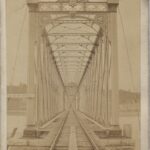
LJTP 100.186 – Dunleith & Dubuque Railroad Bridge – c.1870
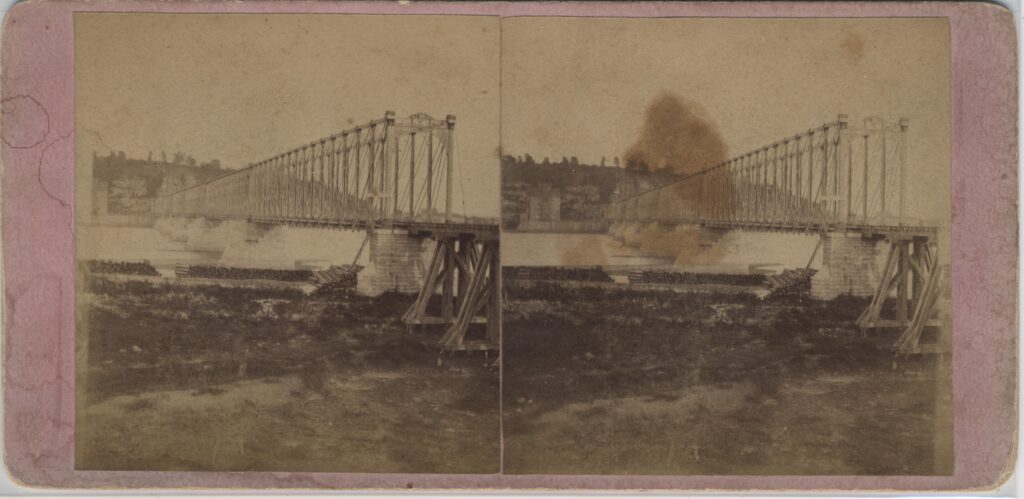
LJTP 100.221 – S. Root SMT – Dunleith Dubuque RR Bridge – c1869
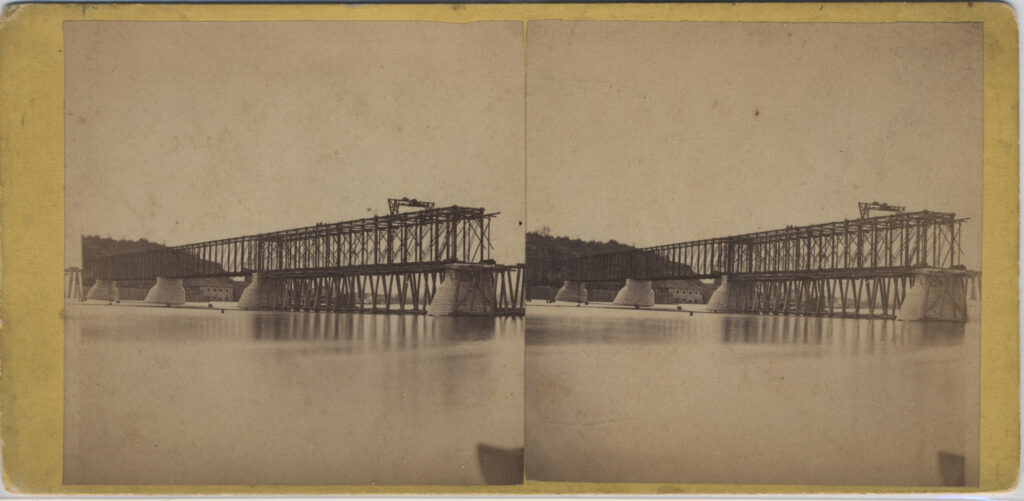
LJTP 100.237 – S. Root – Dunleith & Dubuque RR Bridge – 1868
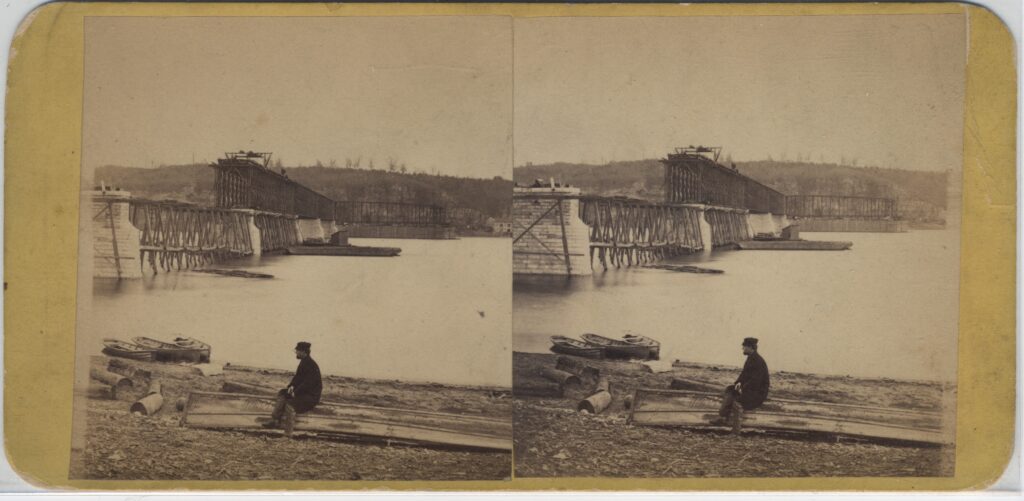
LJTP 100.238 – S. Root – Dunleith & Dubuque RR Bridge – 1868
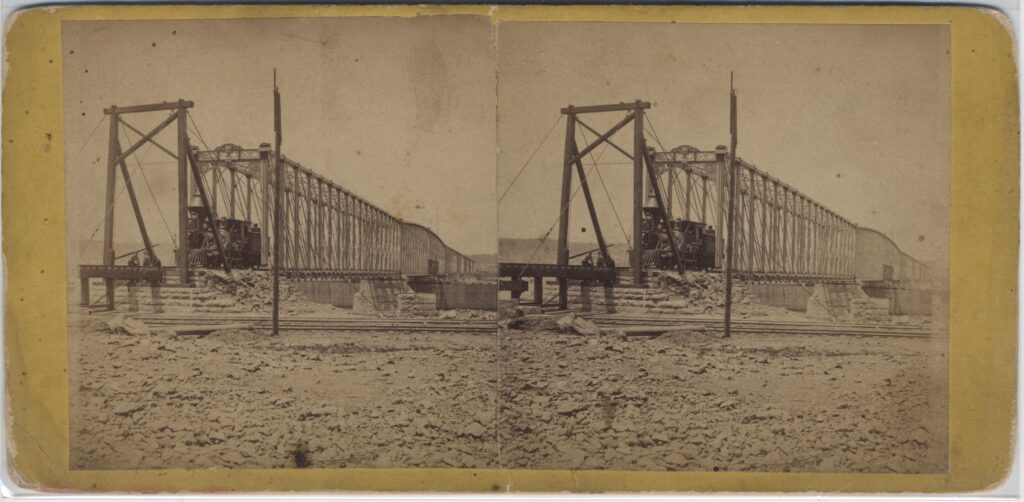
LJTP 100.239 – S. Root – Dunleith & Dubuque RR Bridge – 1869
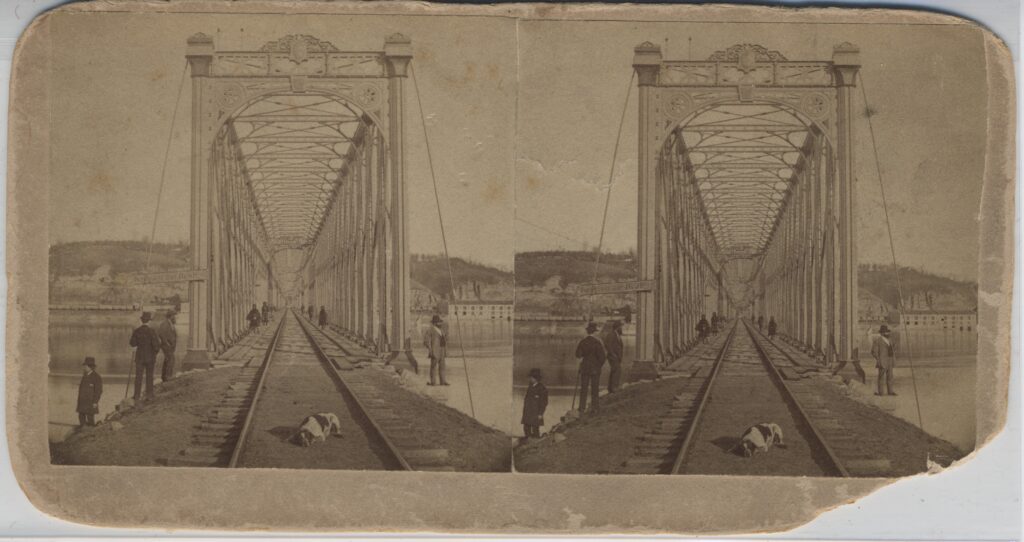
LJTP 100.240 – S. Root – Dunleith & Dubuque RR Bridge – 1869
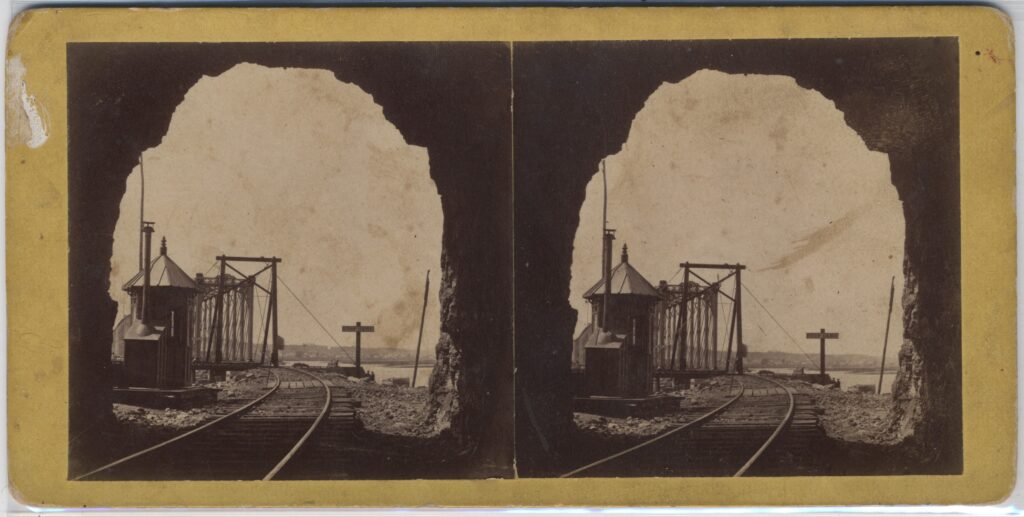
LJTP 100.241 – S. Root – Train Tunnel West – c1869
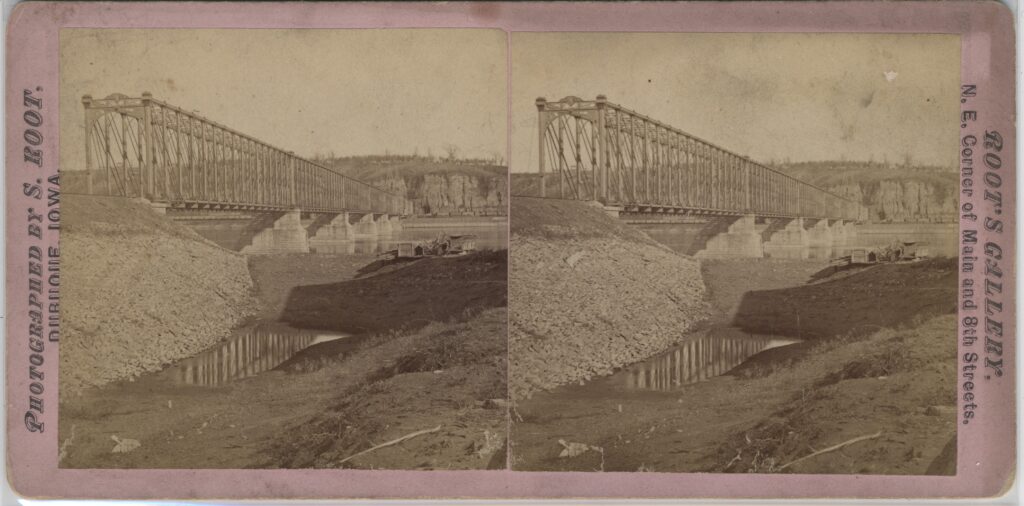
LJTP 100.242 – S. Root – Dunleith & Dubuque RR Bridge – 1869
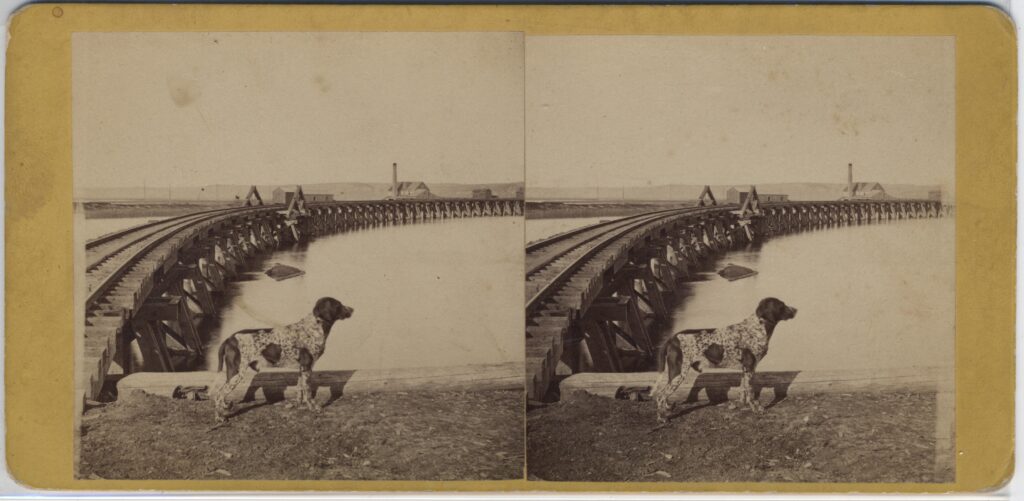
LJTP 100.243 – S. Root – Railroad Bridge Approach – c1870
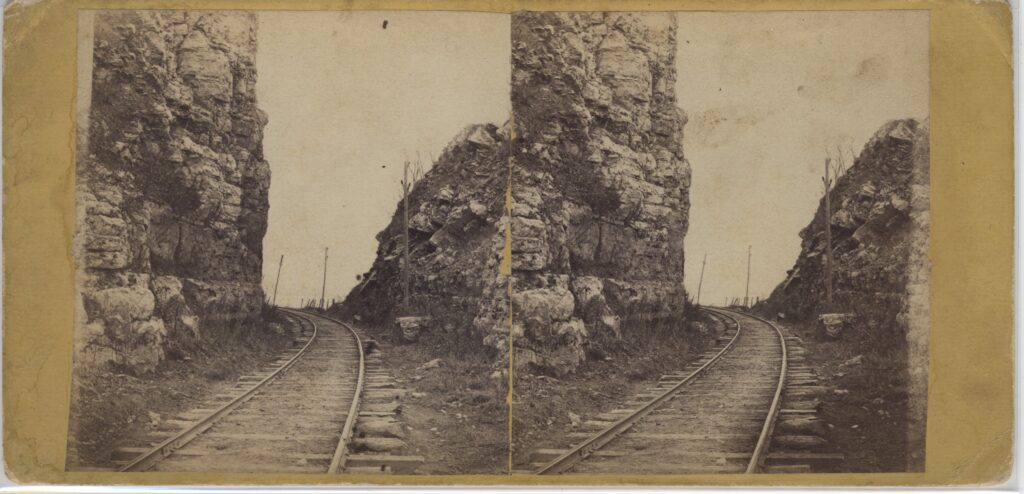
LJTP 100.244 – S. Root – Railroad Rock Cut Dubuque – c1870
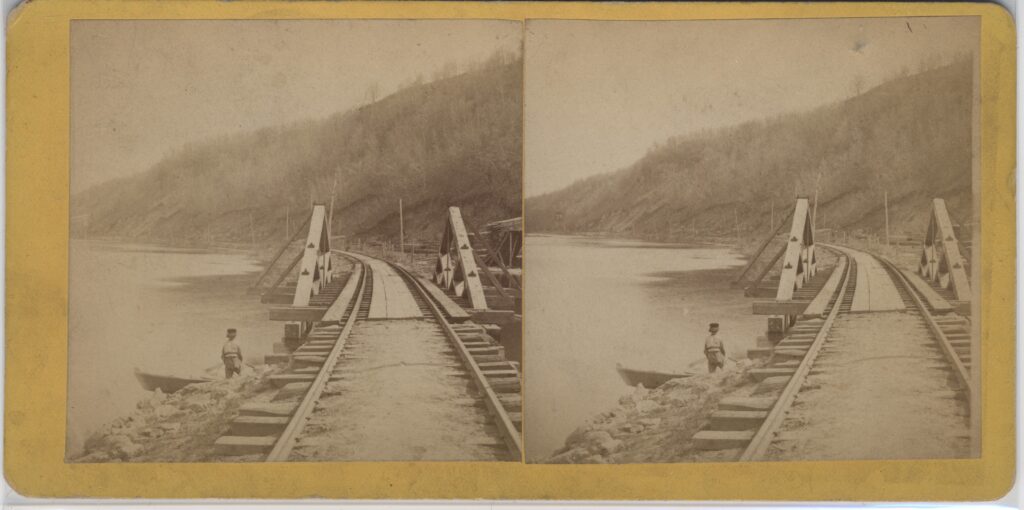
LJTP 100.245 – S. Root – Railroad Tracks South of Dubuque – c1870
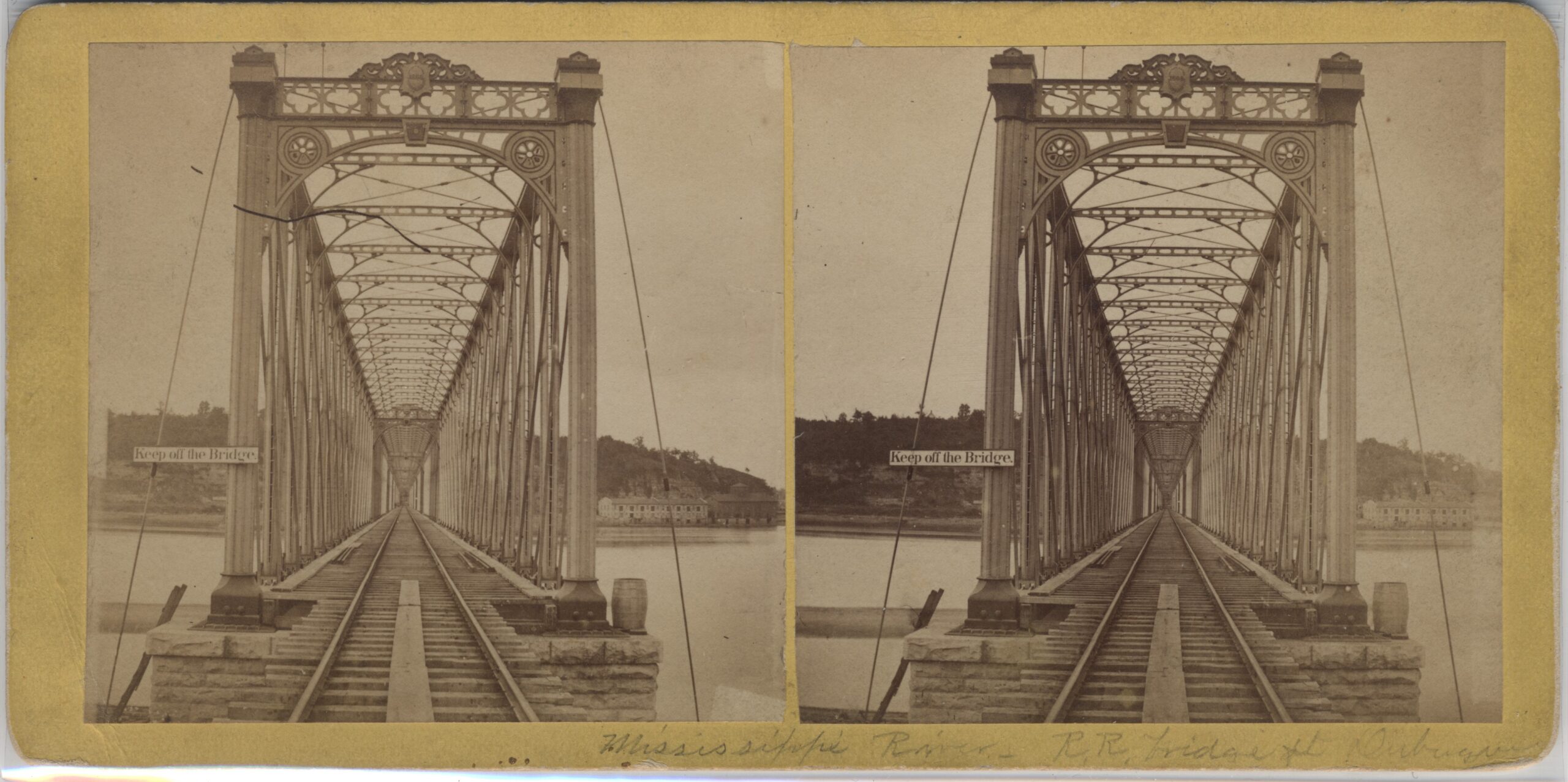
LJTP 100.251 – S. Root SAD – Dunleith & Dubuque RR Bridge – c1875
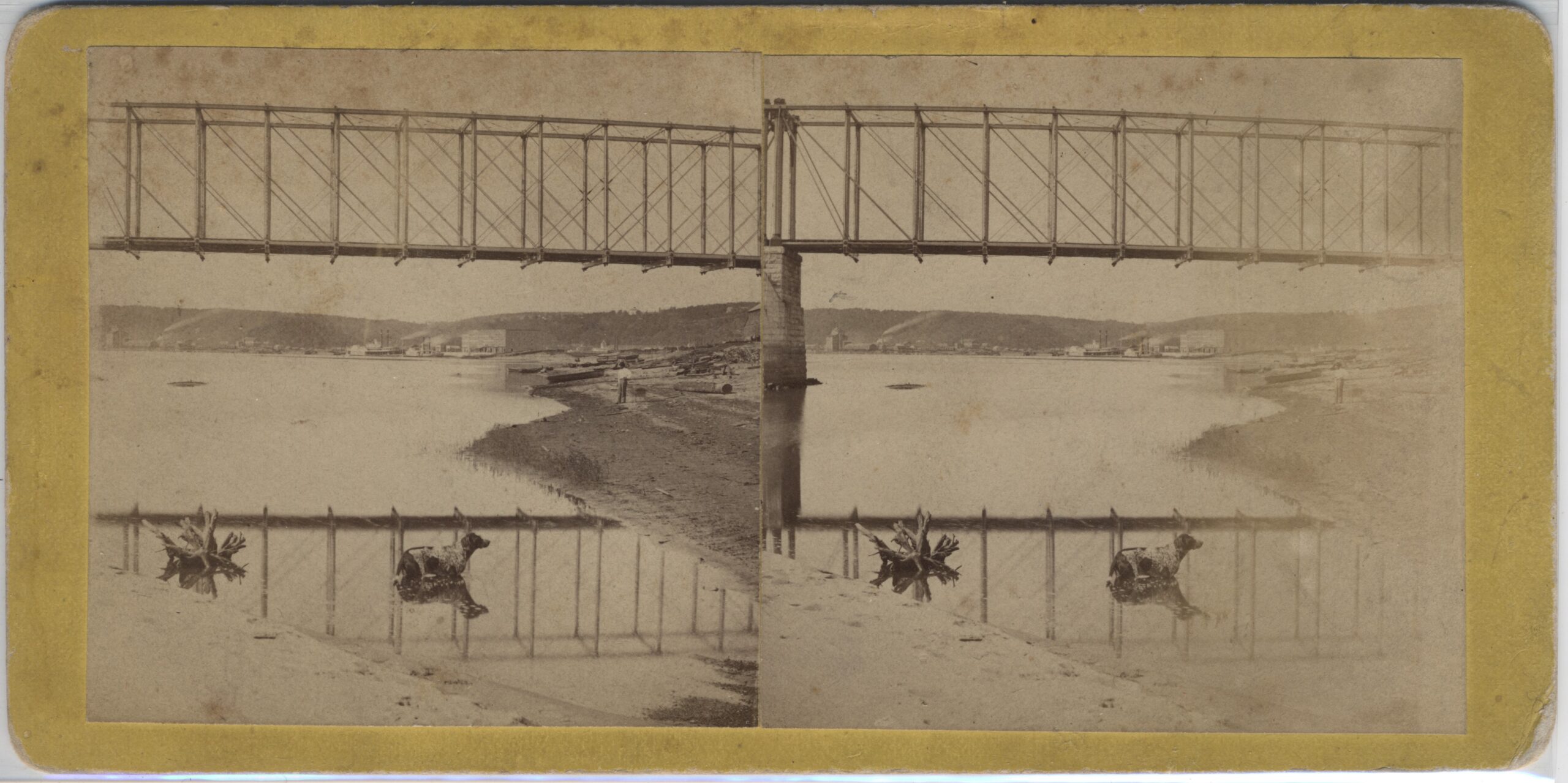
LJTP 100.252 – S. Root SAD – Dunleith & Dubuque RR Bridge – c1875
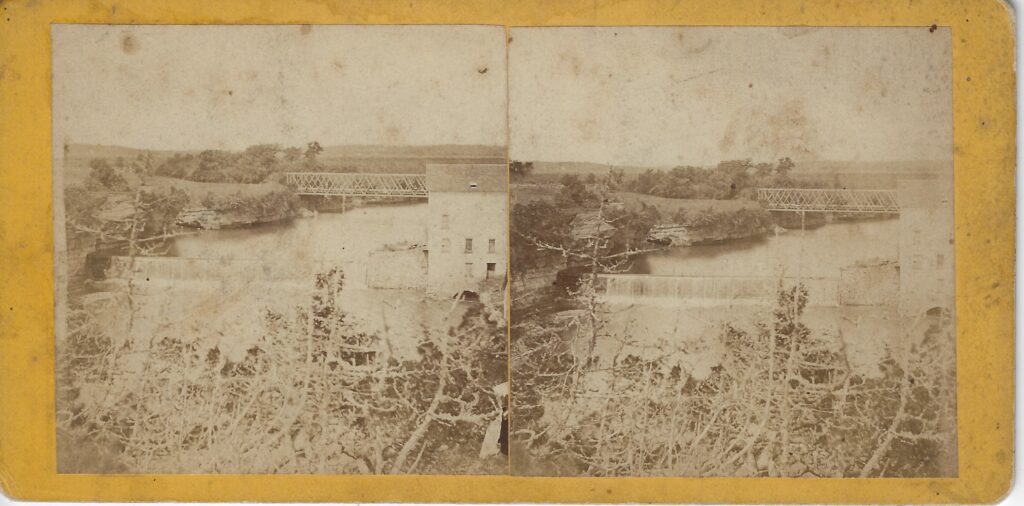
LJTP 100.280 – S. Root IFS – Mill and Railroad Bridge at Iowa Falls – c1875
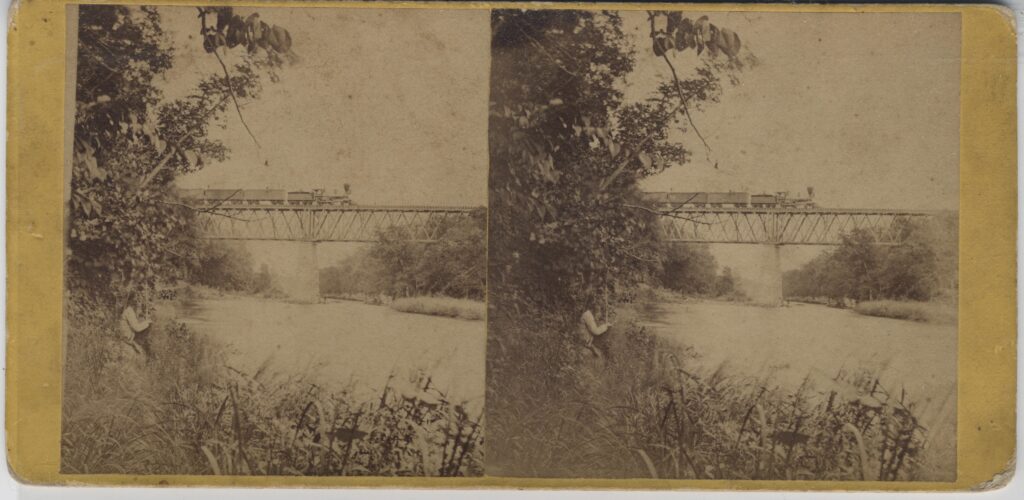
LJTP 100.284 – S. Root – Train on Bridge at Iowa Falls – c1875
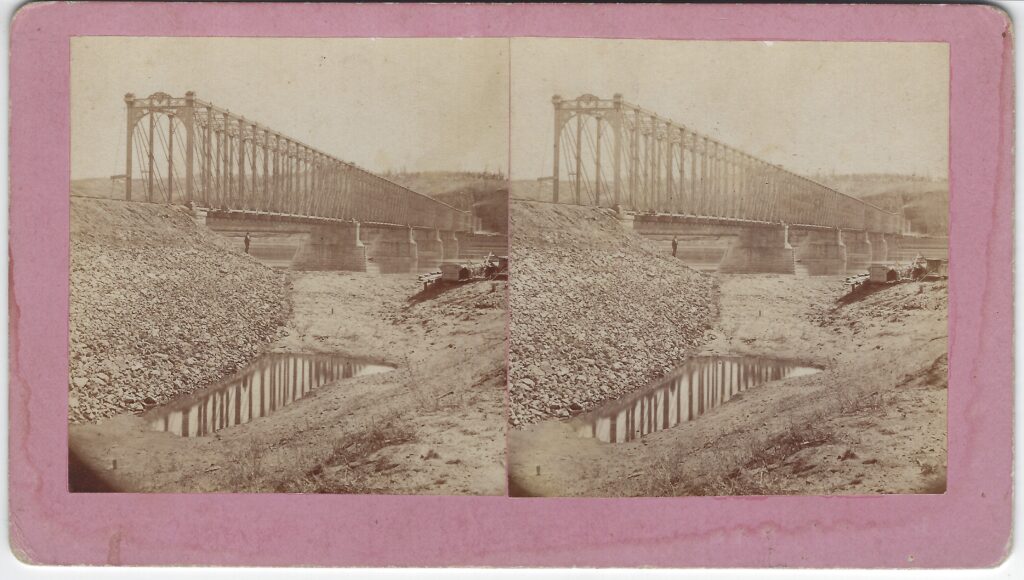
LJTP 100.347 – S. Root – Dunleith & Dubuque Railroad Bridge
Stocks-Bonds & Currency
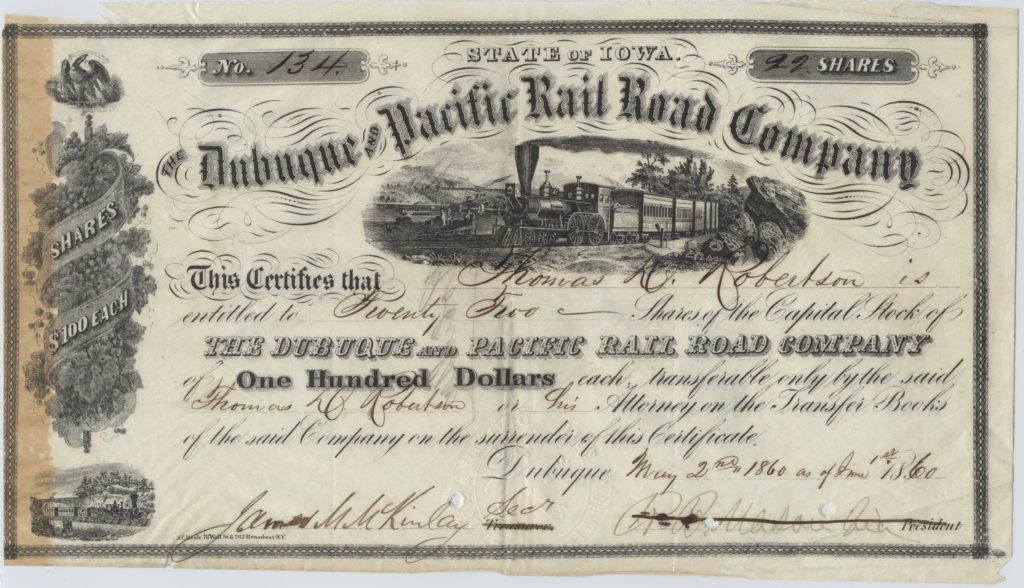
LJTP 400.002 – Dubuque and Pacific RR Stock No. 134
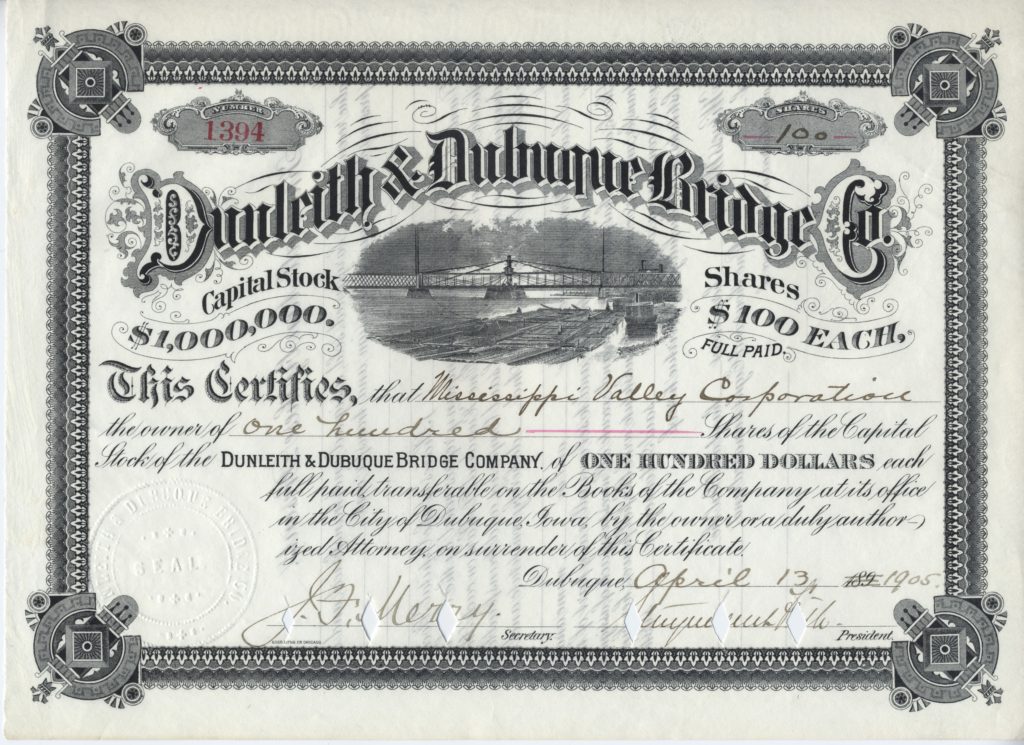
LJTP 400.004 – Dunleith & Dubuque Bridge Co.
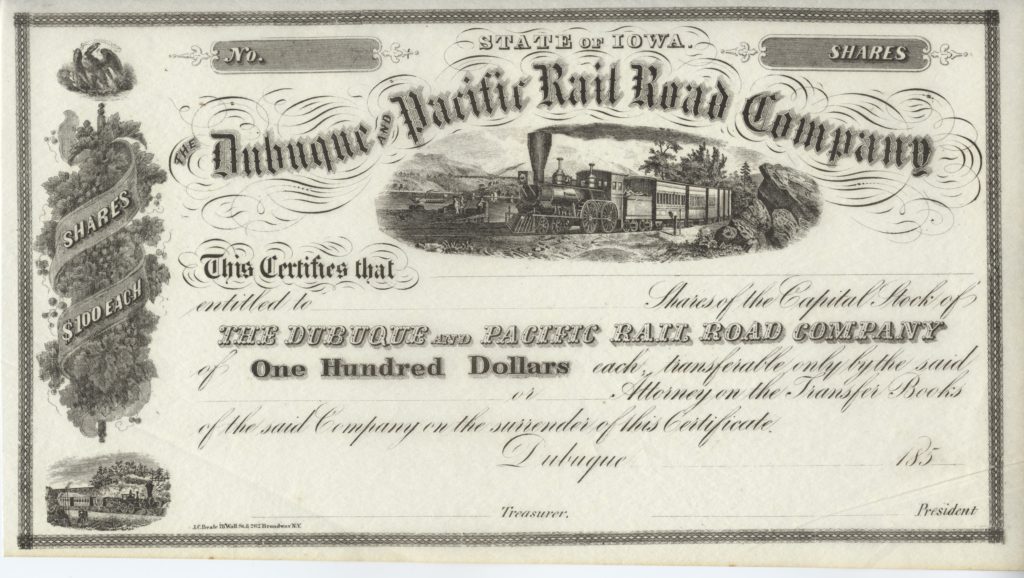
LJTP 400.005 – Dubuque and Pacific RR
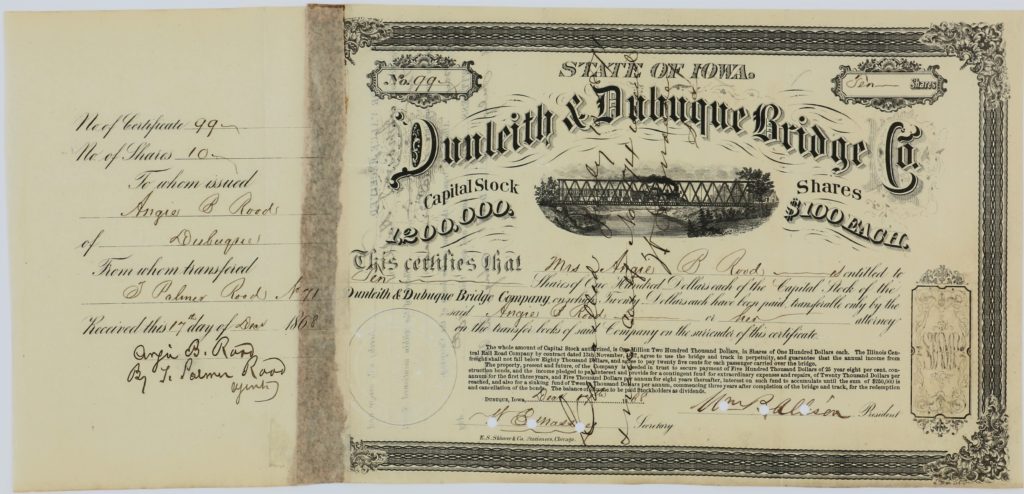
LJTP 400.006 – Dunleith & Dubuque Bridge Co.
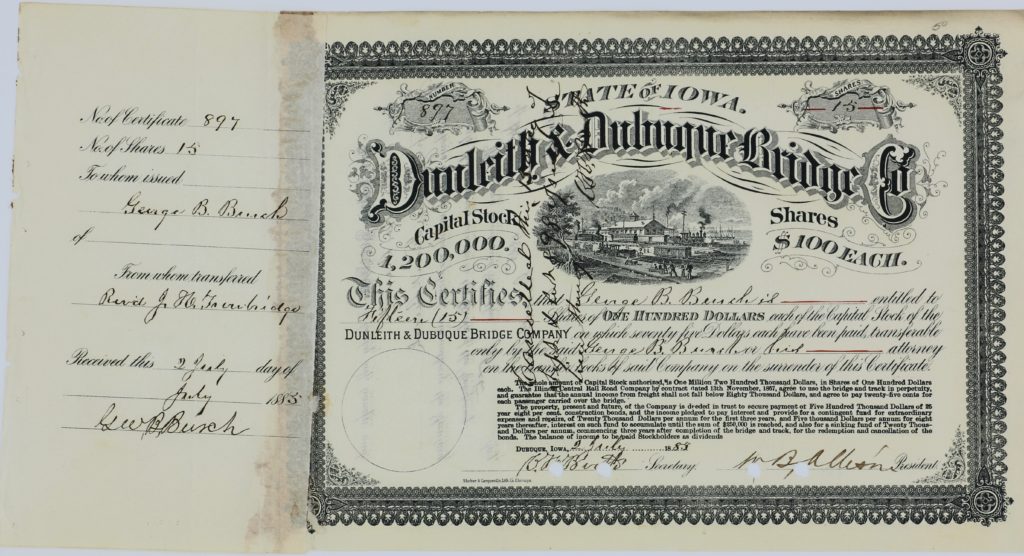
LJTP 400.007 – Dunleith & Dubuque Bridge Co.
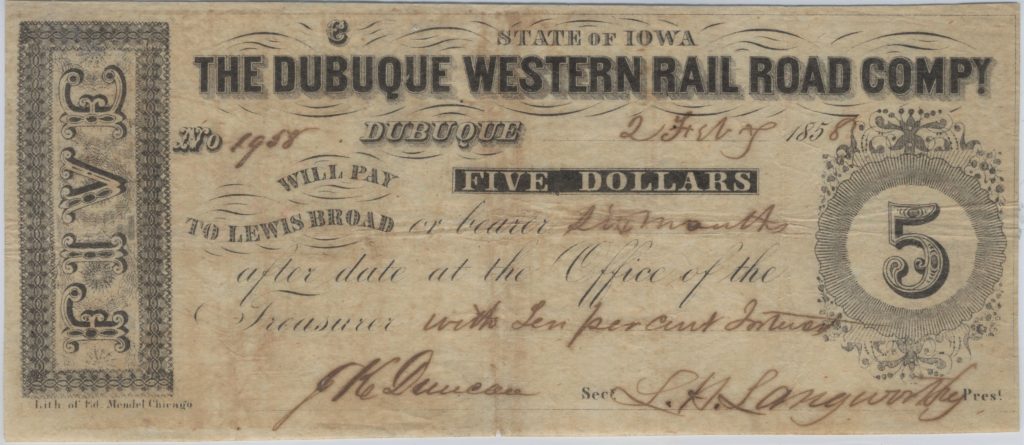
LJTP 400.008 – The Dubuque Western Rail Road Company $5 Note – 1858

LJTP 400.009 – Dunleith & Dubuque Bridge Co. Bond Certificate and Coupons – c.1868
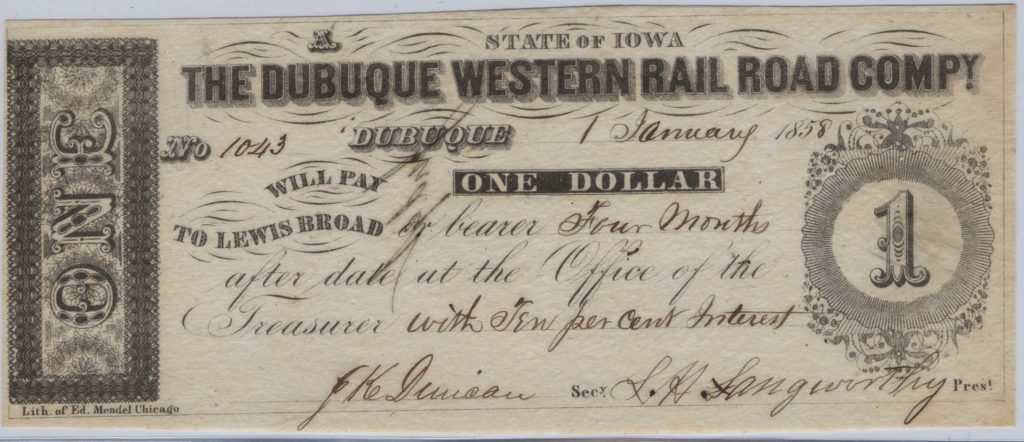
LJTP 400.011 – The Dubuque Western Rail Road Company $1 Note – 1858
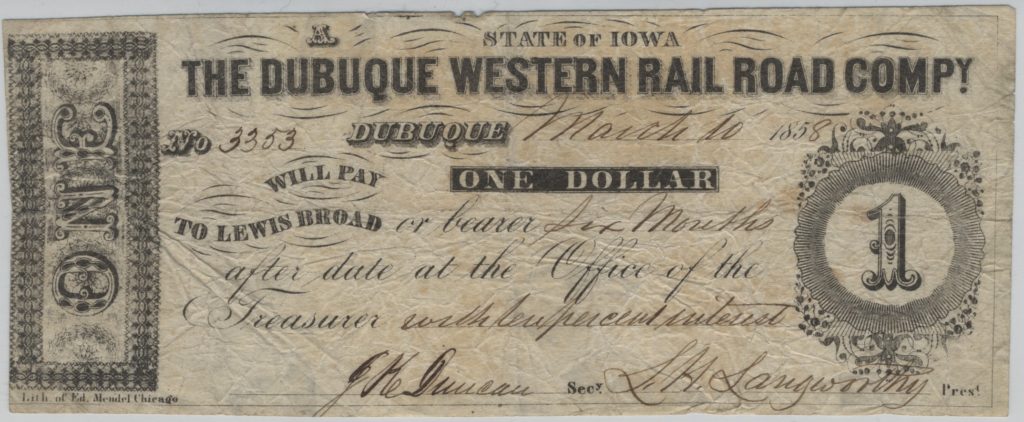
LJTP 400.012 – The Dubuque Western Rail Road Company $1 Note – 1858
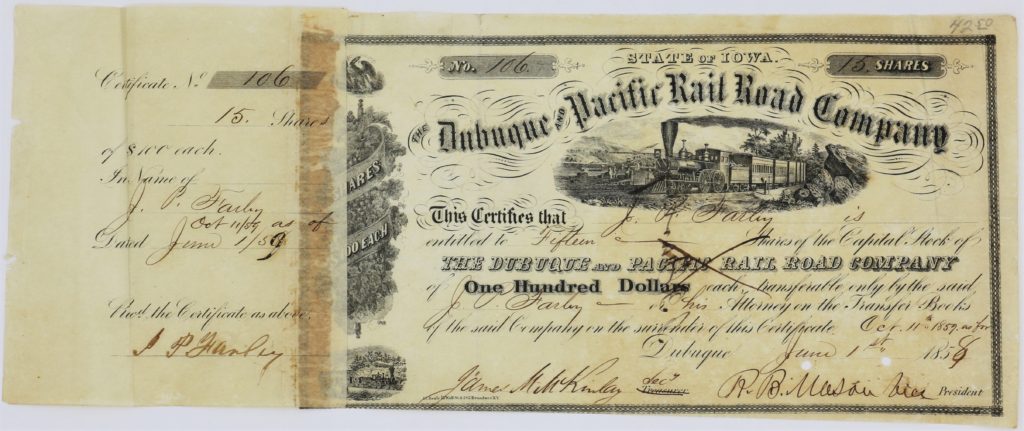
LJTP 400.013 – Dubuque and Pacific RR Stock Certificate – 1859
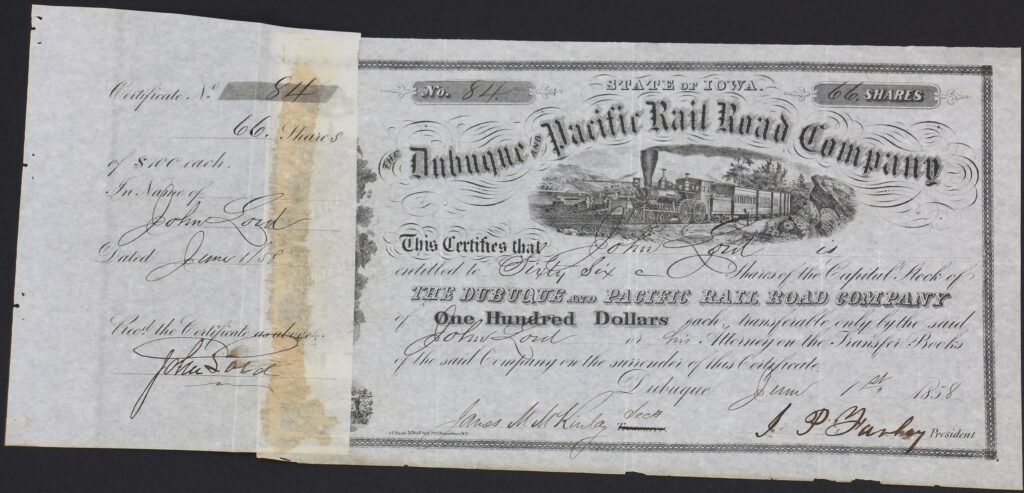
LJTP 400.015 – Dubuque and Pacific RR Stock Certificate – 1858
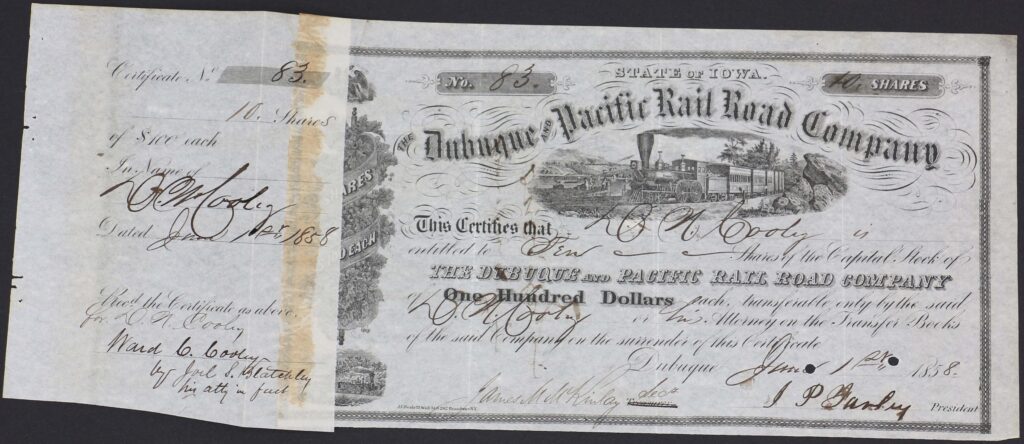
LJTP 400.016 – Dubuque and Pacific RR Stock Certificate – DN Cooley – 1858
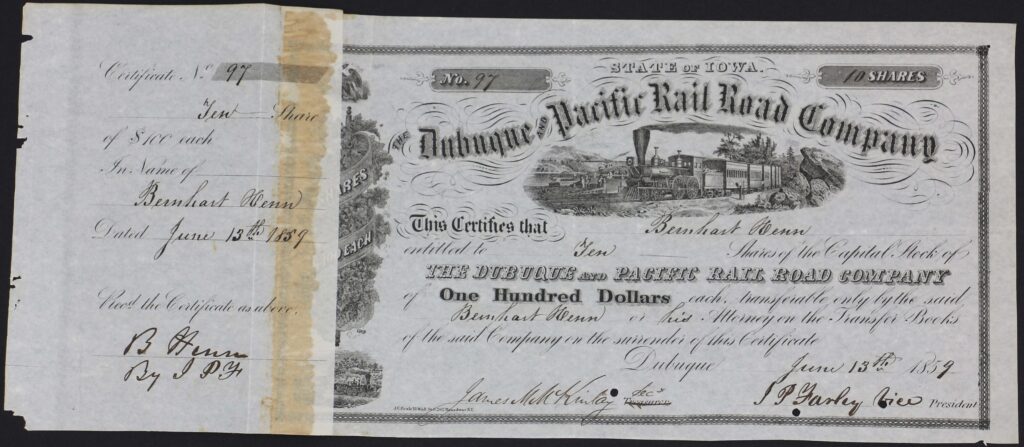
LJTP 400.017 – Dubuque and Pacific RR Stock Certificate – 1859
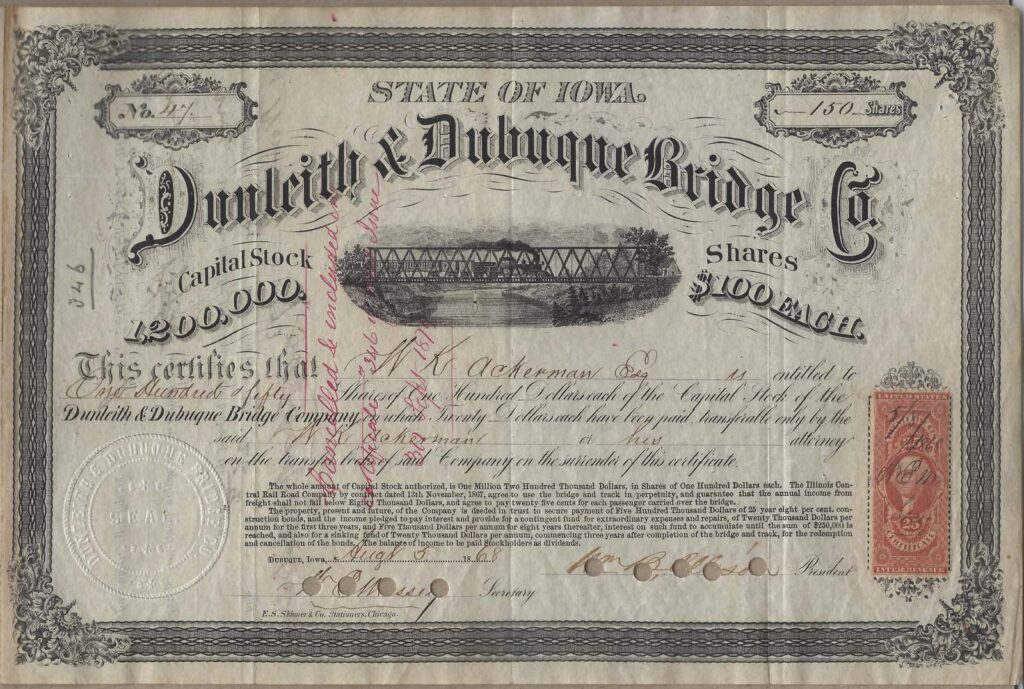
LJTP 400.018 – Dunleith & Dubuque Bridge Co. No. 47 – 1868
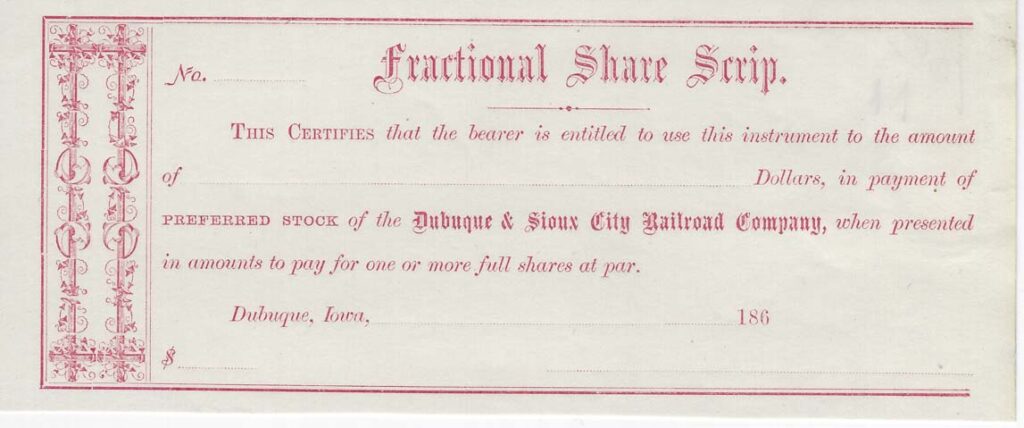
LJTP 400.019 – Dubuque & Sioux City RR Fractional Share Scrip – circa 1861
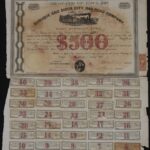 LJTP 400.020 – Dubuque & Sioux City Bond Certificate – 1863
LJTP 400.020 – Dubuque & Sioux City Bond Certificate – 1863
LJTP 400.020 – Dubuque & Sioux City Bond Certificate – 1863
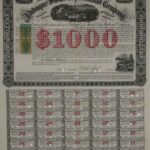 LJTP 400.021 – Dubuque & Sioux City Railroad $1000 Bond – 1867
LJTP 400.021 – Dubuque & Sioux City Railroad $1000 Bond – 1867
LJTP 400.021 – Dubuque & Sioux City Railroad $1000 Bond – 1867
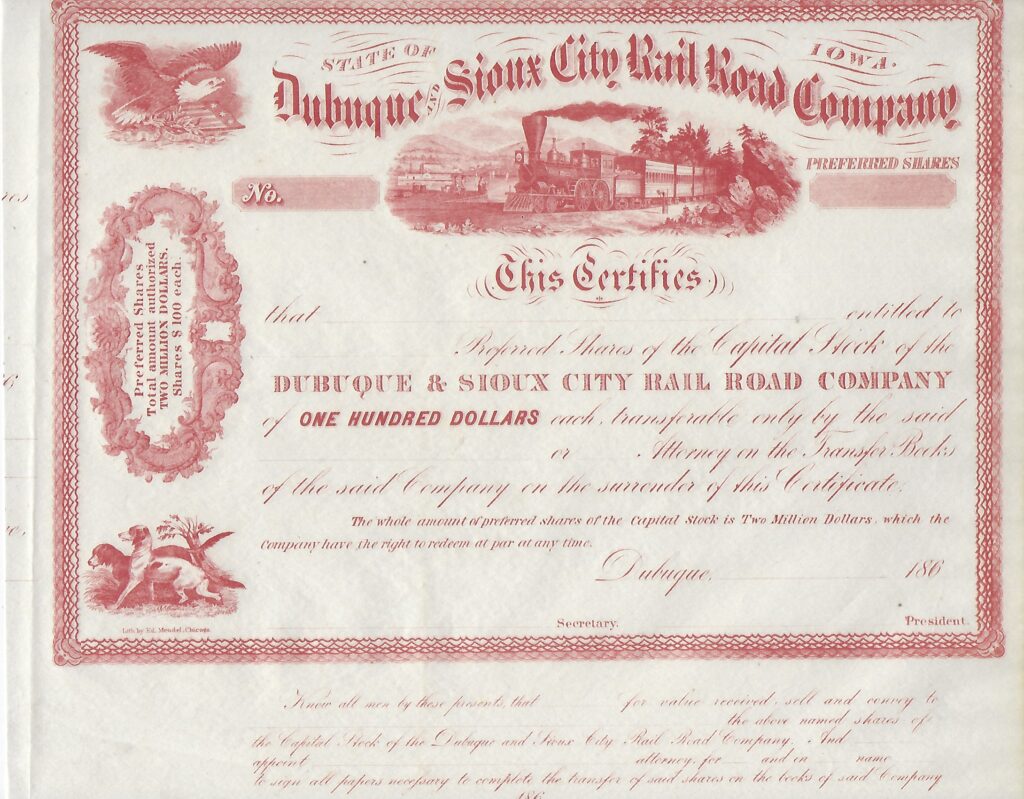
LJTP 400.022 – Dubuque & Sioux City RR – 1860
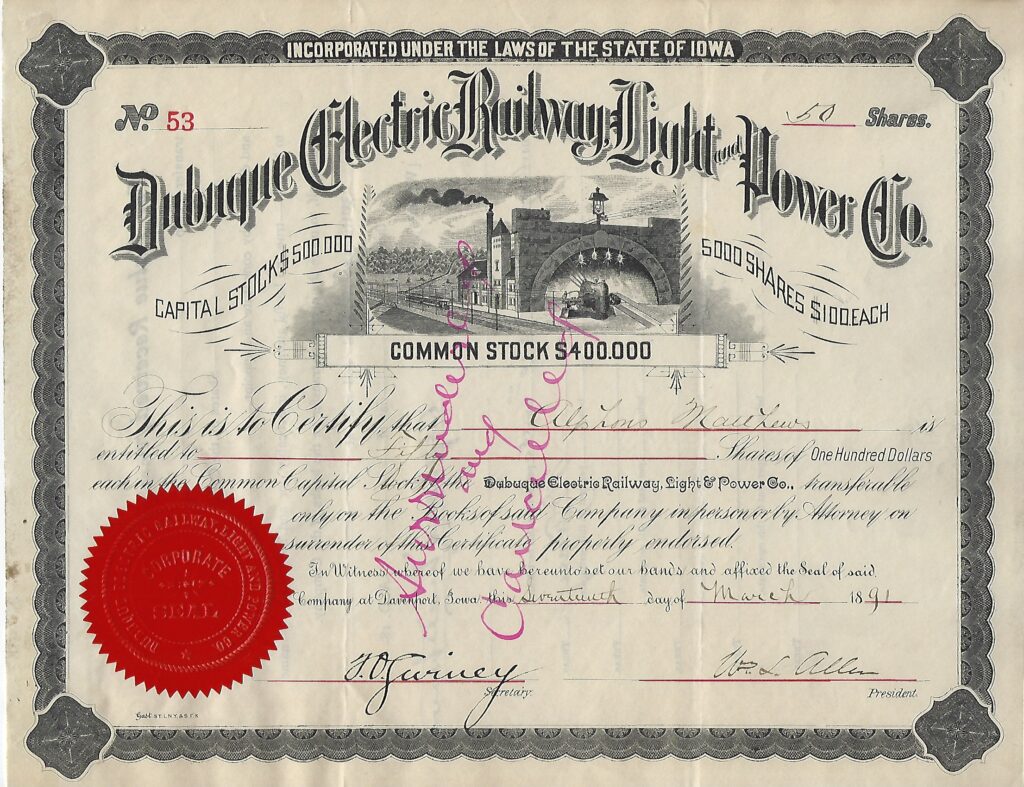
LJTP 400.023 – Dubuque Electric Railway, Light and Power Company – 1891
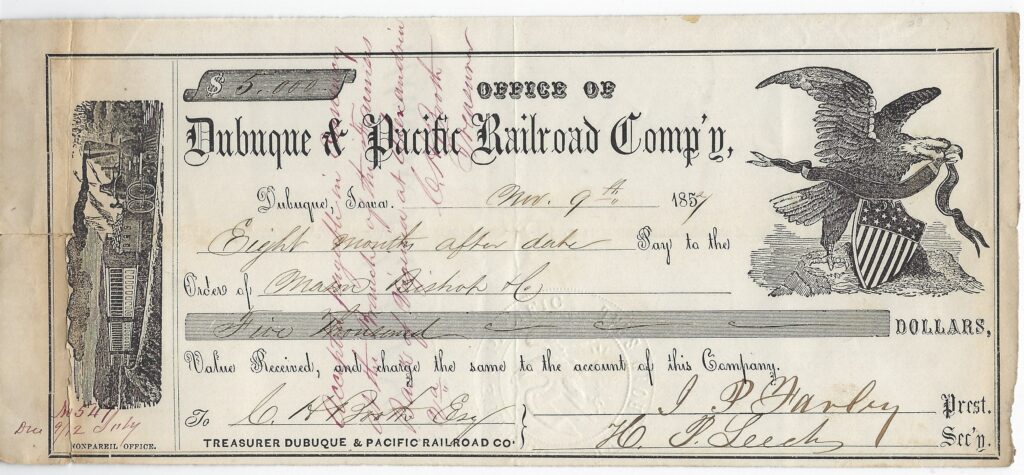
LJTP 400.024 – Dubuque & Pacific Railroad Check – 1857
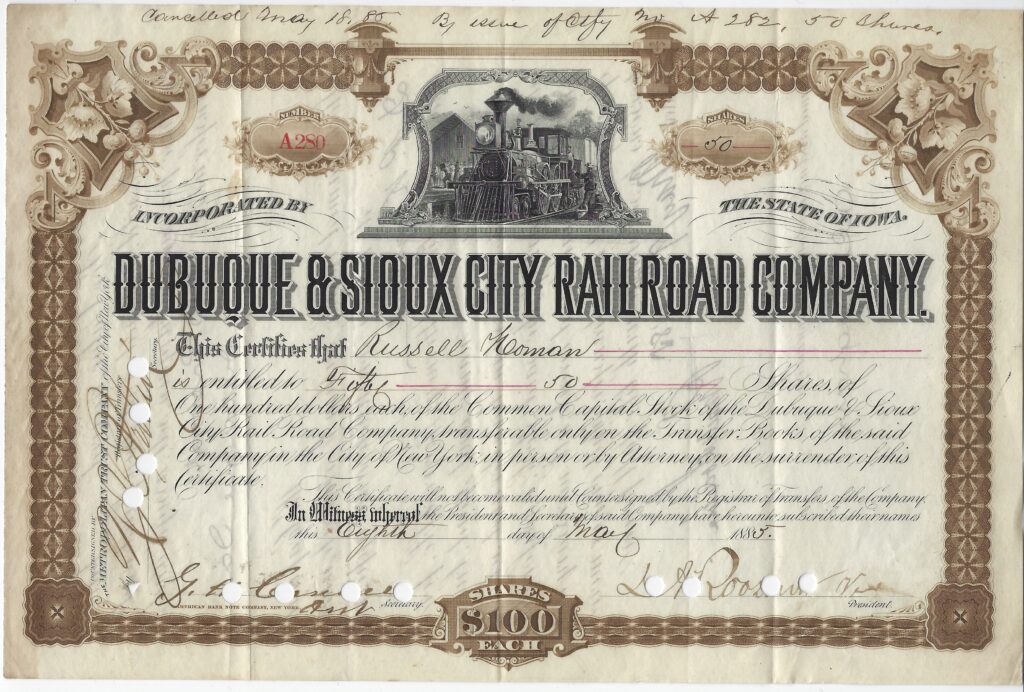
LJTP 400.026 – Dubuque & Sioux City Railroad Stock – James A. Roosevelt – 1885
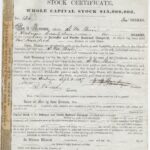
LJTP 400.027 – Dubuque & Pacific Railroad Stock – 1857
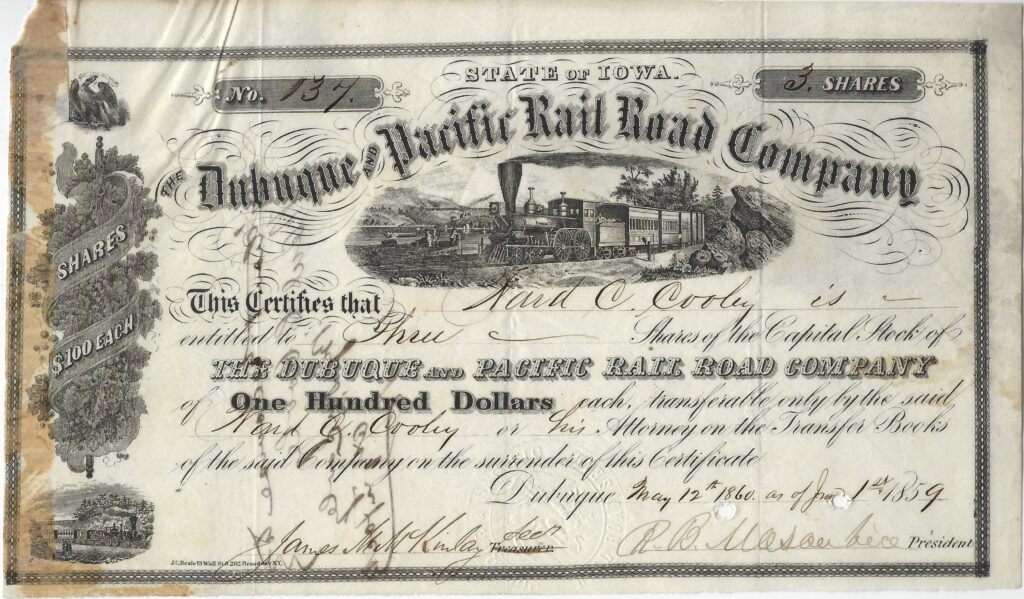
LJTP 400.028 – Dubuque & Pacific Railroad – R.B. Mason – 1859
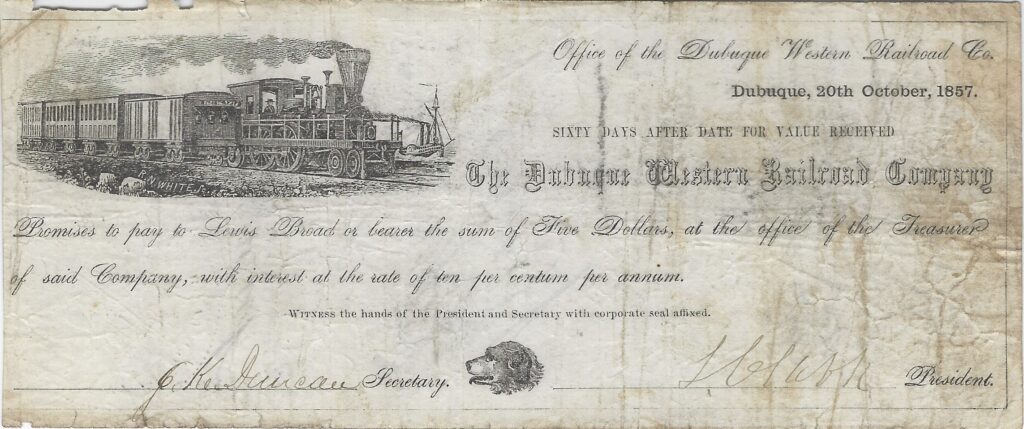
LJTP 400.029 – Dubuque Western Railroad Note – 1857
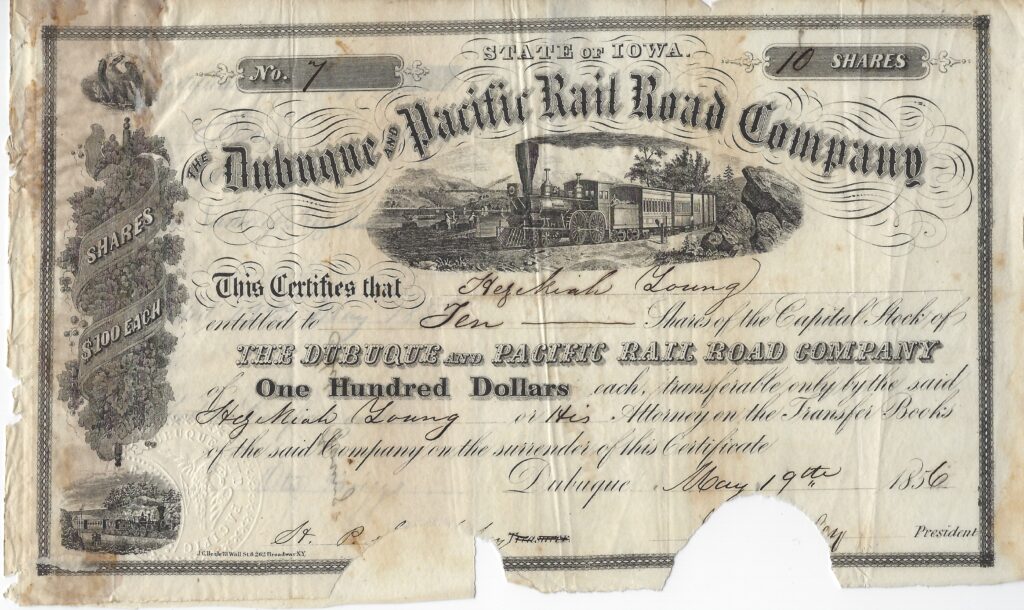
LJTP 400.030 – Dubuque & Pacific Railroad Stock – 1856
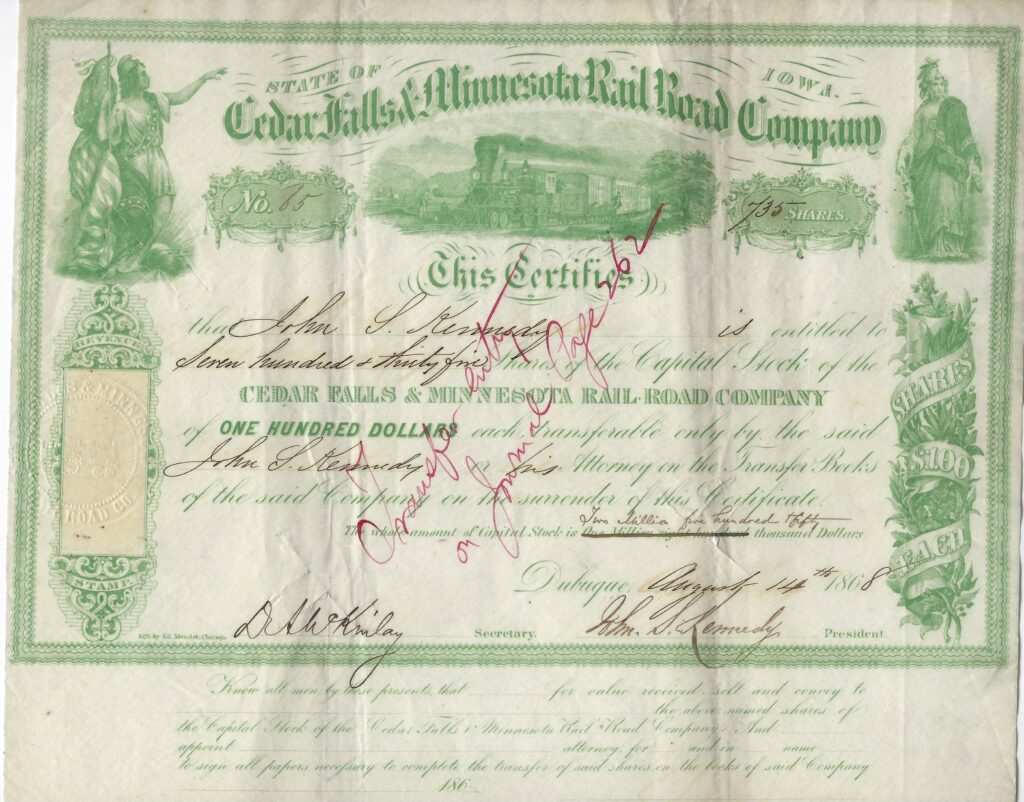
LJTP 400.031 – Cedar Falls & Minnesota Railroad Stock – 1868
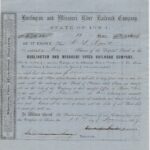
LJTP 400.032 – Burlington & Missouri River Railroad Stock – 1857
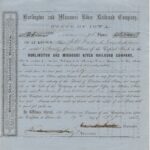
LJTP 400.033 – Burlington & Missouri River Railroad Stock – 1858
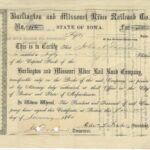
LJTP 400.034 – Burlington & Missouri River Railroad Stock – 1860
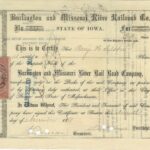
LJTP 400.035 – Burlington & Missouri River Railroad Stock – 1868
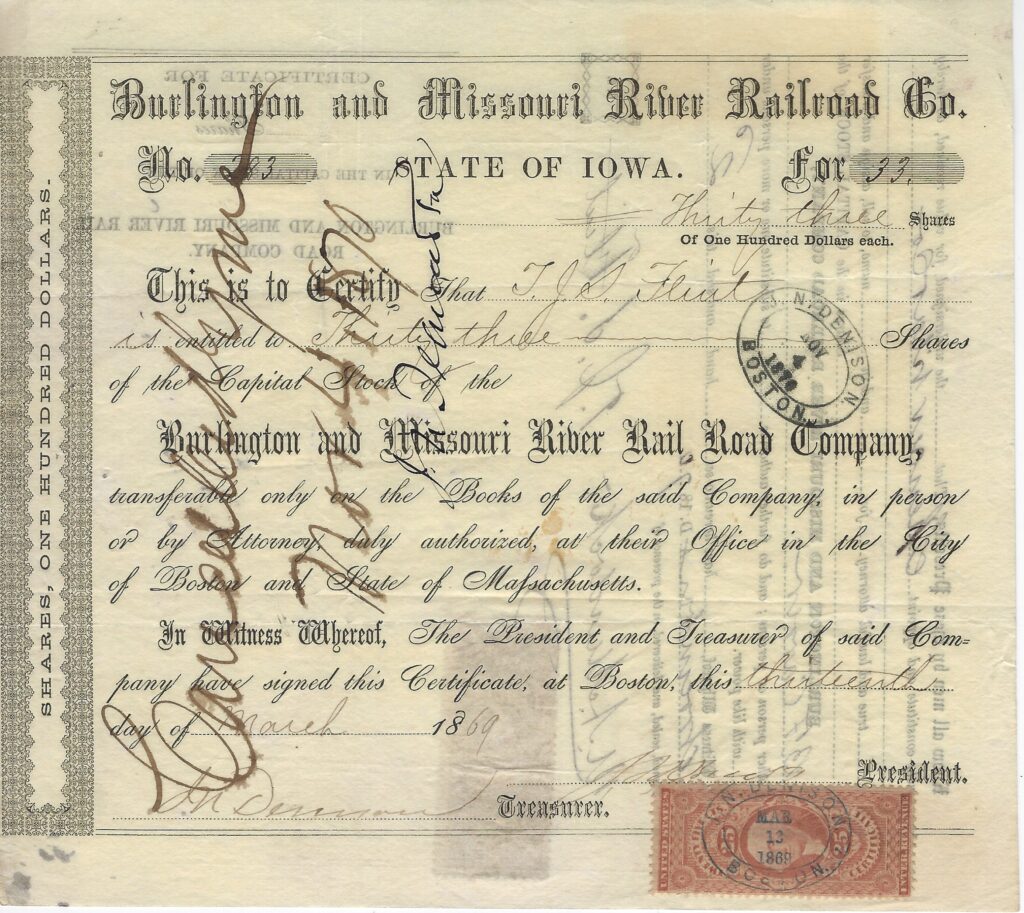
LJTP 400.036 – Burlington & Missouri River Railroad Dbl Stamp Stock – 1869
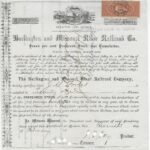
LJTP 400.037 – Burlington & Missouri River Railroad Stock – 1869
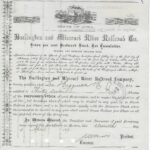
LJTP 400.038 – Burlington & Missouri River Railroad Stock – 1870

LJTP 400.039 – Dubuque & Sioux City Railroad $1000 Bond – Theodore Roosevelt – 1869
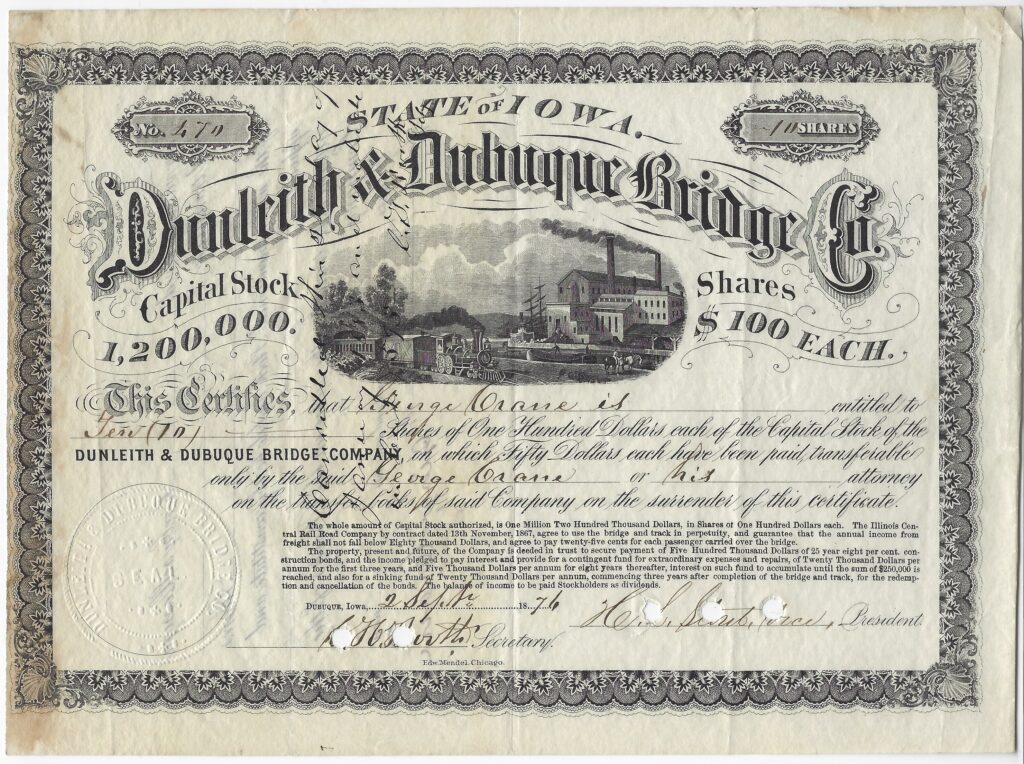
LJTP 400.040 – Dunleith & Dubuque Bridge Co. Stock – George Crane – 1876
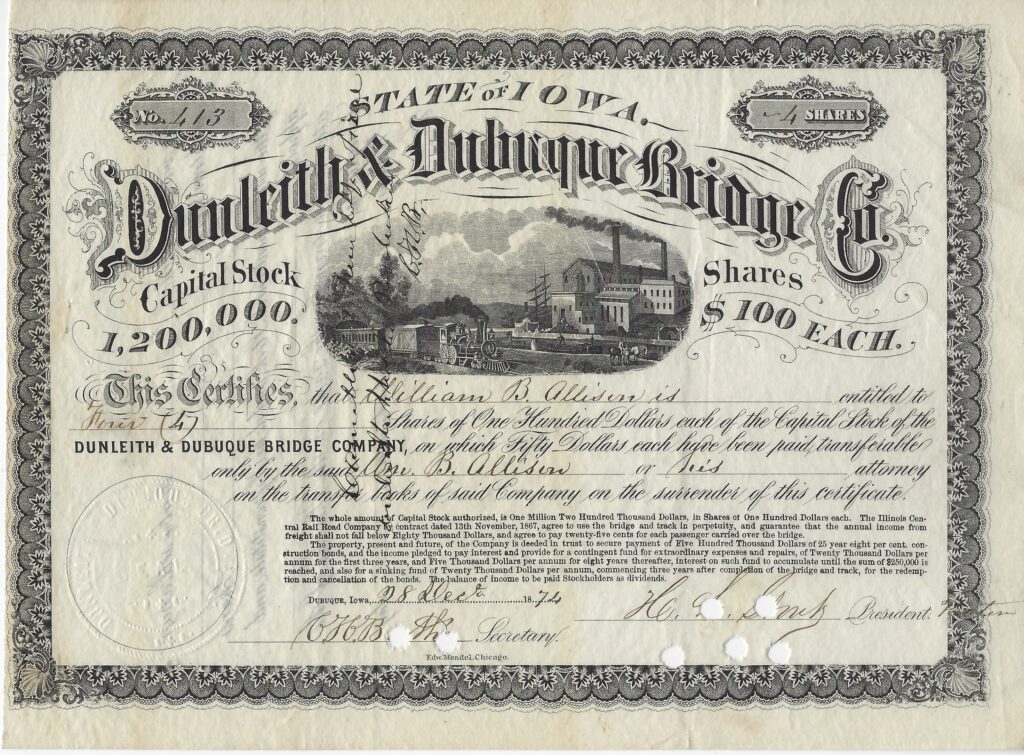
LJTP 400.041 – Dunleith & Dubuque Bridge Co. – Wm B Allison – 1874
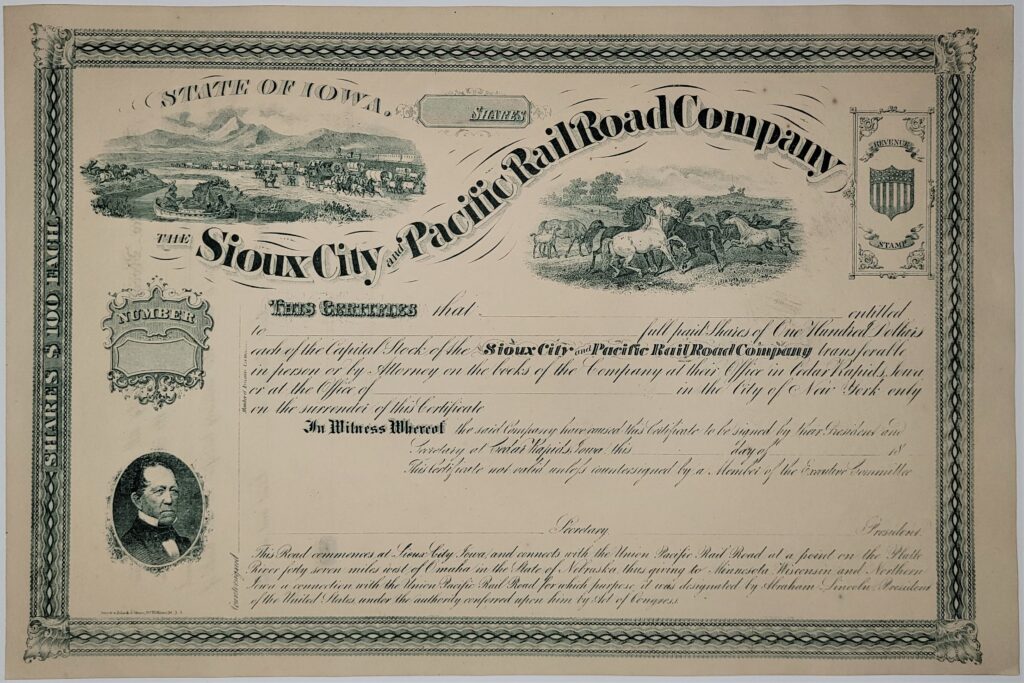
LJTP 400.042 – Sioux City & Pacific Railroad – 186x – Unissued
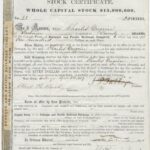
LJTP 400.043 – Dubuque & Pacific Railroad – Charles Gregoire – 1857
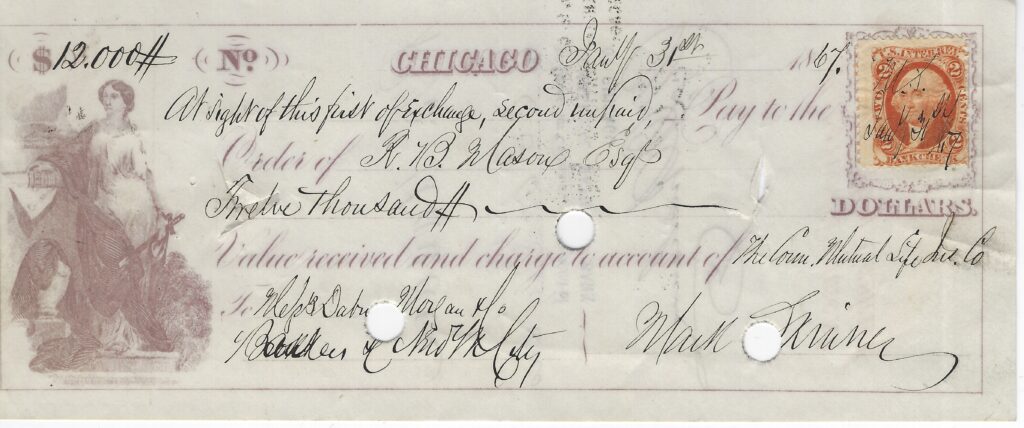
LJTP 400.044 – Cashier Check to RB Mason on JP Morgan Bank – 1867
Maps & Misc.
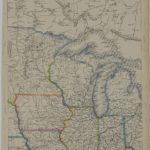
LJTP 500.004 – Weekly Dispatch Atlas – United States of North America – c.1863
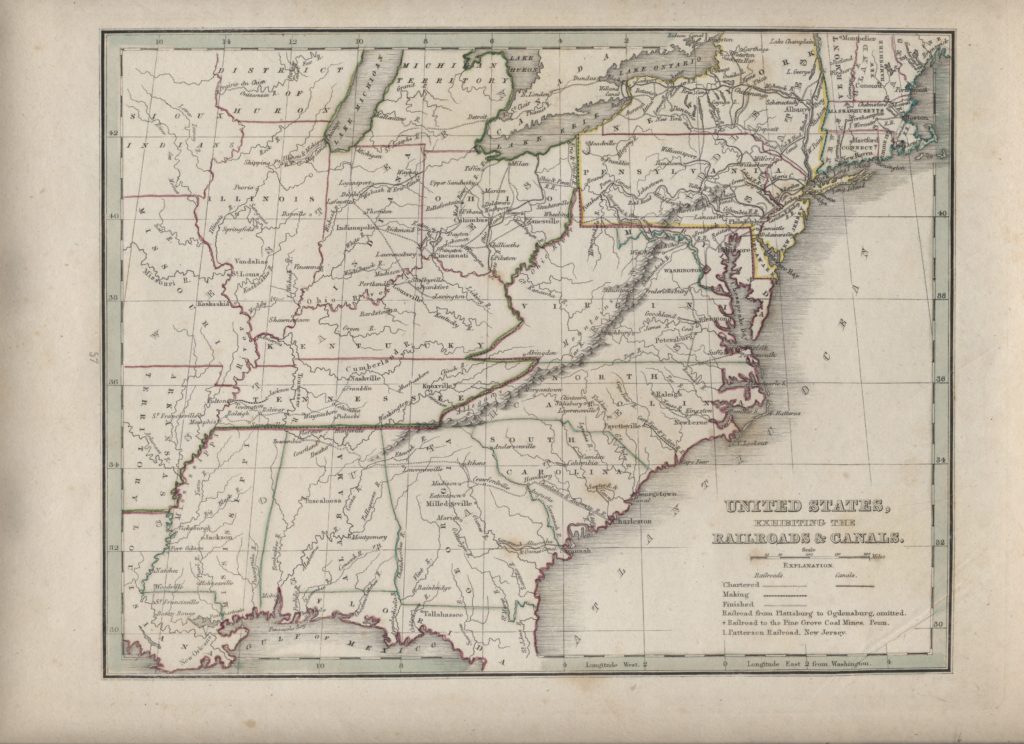 LJTP 500.007 – Comprehensive Atlas Geographical, Historical and Commercial – United States Exhibiting the Railroads and Canals – 1835
LJTP 500.007 – Comprehensive Atlas Geographical, Historical and Commercial – United States Exhibiting the Railroads and Canals – 1835
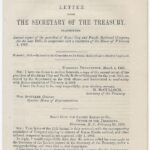
LJTP 300.018 – Congressional Record Sioux City & Pacific Railroad – Feb 4 1868
